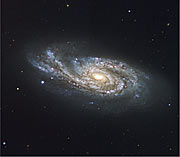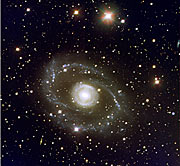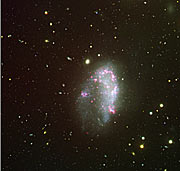Nota de Imprensa
Island Universes with a Twist
VLT Images of Perturbed Galaxies
26 de Julho de 2006
If life is like a box of chocolates - you never know what you will get - the Universe, with its immensely large variety of galaxies, must be a real candy store! ESO's Very Large Telescope has taken images of three different 'Island Universes' [1], each amazing in their own way, whose curious shapes testify of a troubled past, and for one, of a foreseeable doomed future.
The first galaxy pictured is NGC 908, located 65 million light-years towards the constellation of Cetus (the Whale). This spiral galaxy, discovered in 1786 by William Herschel, is a so-called starburst galaxy, that is, a galaxy undergoing a phase where it spawns stars at a frantic rate. Clusters of young and massive stars can be seen in the spiral arms. Two supernovae, the explosions of massive stars, have been recorded in the near past: one in 1994 and another in May of this year. The galaxy, which is about 75 000 light-years long, also clearly presents uneven and thick spiral arms, the one on the left appearing to go upwards, forming a kind of ribbon. These properties indicate that NGC 908 most probably suffered a close encounter with another galaxy, even though none is visible at present.
The second galaxy featured constitutes another wonderful sight yet of a more timid nature: it does not belong to the NGC catalogue [2], like so many of its more famous brethren. Its less well-known designation, ESO 269-G57, refers to the ESO/Uppsala Survey of the Southern Sky in the 1970's during which over 15,000 southern galaxies were found with the ESO Schmidt telescope and catalogued.
Located about 155 million light-years away towards the southern constellation Centaurus (the Centaur), ESO 269-G57 is a spectacular spiral galaxy of symmetrical shape that belongs to a well-known cluster of galaxies seen in this direction. An inner 'ring', of several tightly wound spiral arms, surrounded by two outer ones that appear to split into several branches, are clearly visible. Many blue and diffuse objects are seen - most are star-forming regions. ESO 269-G57 extends over about 4 arc minutes in the sky, corresponding to nearly 200,000 light-years across. Resembling a large fleet of spaceships, many other faint, distant galaxies are visible in the background.
Finally, ESO Press Release eso0627 provides a view of a more tormented organism, a so-called irregular galaxy, known as NGC 1427A. Located about 60 million light-years away, in the direction of the constellation Fornax (the Furnace), NGC 1427A is about 20,000 light-years long and shares some resemblances with our neighbouring Large Magellanic Cloud. NGC 1427A is in fact plunging into the Fornax cluster of galaxies at a speed of 600 km/s, and takes an arrowhead shape. Moving so rapidly, the galaxy is compressed by the intracluster gas, and this compression gives birth to many new stars.
Using these and other VLT observations, astronomer Iskren Y. Georgiev from the Argelander Institute for Astronomy at Bonn (Germany) and his colleagues [3] were able to find 38 candidates globular clusters that are about 10 billion years old. The scientists also inferred that NGC 1427A is about 10 million light-years in front of the central dominant elliptical galaxy in the Fornax cluster of galaxies, NGC 1399. It seems certain that under such circumstances, the future of NGC 1427A looks bleak, as the galaxy will finally be disrupted, dispersing its content of gas and stars in the intracluster regions.
Just next to NGC 1427A, but 25 times further away, a more typical, beautiful face-on spiral galaxy is looking rather unperturbed at the dramatic spectacle.
The multi-mode FORS instrument, on ESO's Very Large Telescope, was used to take the images of these three galaxies. The observations were done in several filters which were then combined to produce a colour image. More information on each of the images is given in the respective captions.
Notas
[1]: In 1755, the German philosopher Immanuel Kant published a book called "Universal Natural History and the Theory of Heavens", in which he put forward the possibility that the nebulous object seen through telescopes could be collections of stars outside our Galaxy. Kant called them 'Island Universes'.
[2]: NGC stands for "New General Catalogue". Published in 1888 by J.L.E. Dreyer, this "New General Catalogue of Nebulae and Clusters of Stars, being the Catalogue of the late Sir John F.W. Herschel" contains 7840 objects of which 3200 are galaxies.
[3]: This result was published in "The old globular cluster system of the dIrr galaxy NGC 1427A in the Fornax cluster" by I.Y. Georgiev et al., Astronomy and Astrophysics, 452, 154 (2006).
Sobre a Nota de Imprensa
| Nº da Notícia: | eso0627 |
| Legacy ID: | PR 27/06 |
| Nome: | ESO 269-G57, NGC 1427A, NGC 908 |
| Tipo: | Local Universe : Galaxy : Activity : Starburst |
| Facility: | Very Large Telescope |
| Instrumentos: | FORS1, ISAAC |
| Science data: | 2006A&A...452..141G |
Our use of Cookies
We use cookies that are essential for accessing our websites and using our services. We also use cookies to analyse, measure and improve our websites’ performance, to enable content sharing via social media and to display media content hosted on third-party platforms.
ESO Cookies Policy
The European Organisation for Astronomical Research in the Southern Hemisphere (ESO) is the pre-eminent intergovernmental science and technology organisation in astronomy. It carries out an ambitious programme focused on the design, construction and operation of powerful ground-based observing facilities for astronomy.
This Cookies Policy is intended to provide clarity by outlining the cookies used on the ESO public websites, their functions, the options you have for controlling them, and the ways you can contact us for additional details.
What are cookies?
Cookies are small pieces of data stored on your device by websites you visit. They serve various purposes, such as remembering login credentials and preferences and enhance your browsing experience.
Categories of cookies we use
Essential cookies (always active): These cookies are strictly necessary for the proper functioning of our website. Without these cookies, the website cannot operate correctly, and certain services, such as logging in or accessing secure areas, may not be available; because they are essential for the website’s operation, they cannot be disabled.
Functional Cookies: These cookies enhance your browsing experience by enabling additional features and personalization, such as remembering your preferences and settings. While not strictly necessary for the website to function, they improve usability and convenience; these cookies are only placed if you provide your consent.
Analytics cookies: These cookies collect information about how visitors interact with our website, such as which pages are visited most often and how users navigate the site. This data helps us improve website performance, optimize content, and enhance the user experience; these cookies are only placed if you provide your consent. We use the following analytics cookies.
Matomo Cookies:
This website uses Matomo (formerly Piwik), an open source software which enables the statistical analysis of website visits. Matomo uses cookies (text files) which are saved on your computer and which allow us to analyze how you use our website. The website user information generated by the cookies will only be saved on the servers of our IT Department. We use this information to analyze www.eso.org visits and to prepare reports on website activities. These data will not be disclosed to third parties.
On behalf of ESO, Matomo will use this information for the purpose of evaluating your use of the website, compiling reports on website activity and providing other services relating to website activity and internet usage.
Matomo cookies settings:
Additional Third-party cookies on ESO websites: some of our pages display content from external providers, e.g. YouTube.
Such third-party services are outside of ESO control and may, at any time, change their terms of service, use of cookies, etc.
YouTube: Some videos on the ESO website are embedded from ESO’s official YouTube channel. We have enabled YouTube’s privacy-enhanced mode, meaning that no cookies are set unless the user actively clicks on the video to play it. Additionally, in this mode, YouTube does not store any personally identifiable cookie data for embedded video playbacks. For more details, please refer to YouTube’s embedding videos information page.
Cookies can also be classified based on the following elements.
Regarding the domain, there are:
- First-party cookies, set by the website you are currently visiting. They are stored by the same domain that you are browsing and are used to enhance your experience on that site;
- Third-party cookies, set by a domain other than the one you are currently visiting.
As for their duration, cookies can be:
- Browser-session cookies, which are deleted when the user closes the browser;
- Stored cookies, which stay on the user's device for a predetermined period of time.
How to manage cookies
Cookie settings: You can modify your cookie choices for the ESO webpages at any time by clicking on the link Cookie settings at the bottom of any page.
In your browser: If you wish to delete cookies or instruct your browser to delete or block cookies by default, please visit the help pages of your browser:
Please be aware that if you delete or decline cookies, certain functionalities of our website may be not be available and your browsing experience may be affected.
You can set most browsers to prevent any cookies being placed on your device, but you may then have to manually adjust some preferences every time you visit a site/page. And some services and functionalities may not work properly at all (e.g. profile logging-in, shop check out).
Updates to the ESO Cookies Policy
The ESO Cookies Policy may be subject to future updates, which will be made available on this page.
Additional information
For any queries related to cookies, please contact: pdprATesoDOTorg.
As ESO public webpages are managed by our Department of Communication, your questions will be dealt with the support of the said Department.



